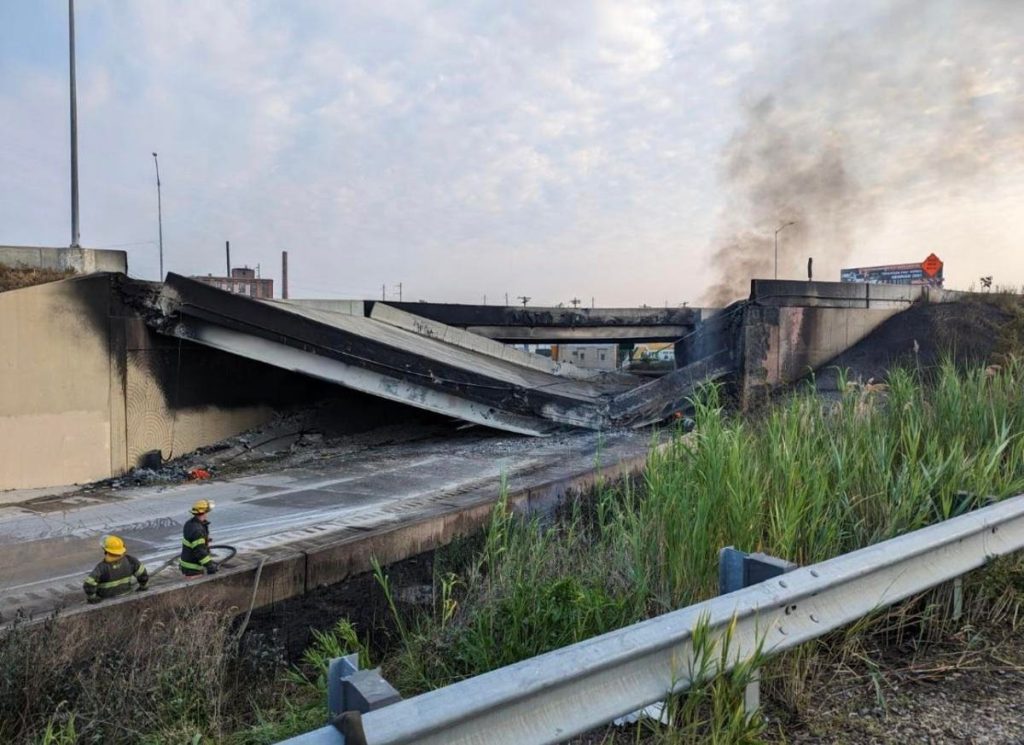The trifecta of federal legislation the previous Congress passed and President Biden signed into law provides about $3 trillion in funding and incentives to shore up, rebuild or reinvent the U.S. infrastructure, especially to mitigate climate change and bring American communities into the 21st century. The Inflation Reduction Act, Infrastructure Investment and Jobs Act and CHIPS and Science Act are each focused on upgrading our infrastructure in different ways. These upgrades can only be built, and therefore, have an impact, through public-private partnerships; the government can only do so much on its own.
Partnerships are magic. They are about leveraging each other’s resources to have a much bigger impact, making the pie a lot larger, and exponentially increasing who can benefit, in what ways, and by how much, and usually making it all happen faster.
When a major stretch of I-95 near Philadelphia collapsed due to a tanker truck fire a few months ago (pictured), for example, many experts said it would take months to rebuild. But Pennsylvania Governor Josh Shapiro partnered with the Biden administration, the Pennsylvania Department of Transportation and Emergency Management Agency, State Troopers, and the Philadelphia-based private highway contractor Buckley & Co. to rebuild the roadway, and got it done in a record-breaking two weeks. They used local tradespeople, even took climate-friendly steps such as using recycled glass to shore up the new roadway, and had the construction livestreamed to be transparent for the public.
What makes for strong, effective, mutually-beneficial public-private partnerships?
At the MOVE: Mobility Reimagined 2023 conference this week in Austin, Texas, I had the privilege of moderating a panel of people who are building and implementing these public-private partnerships every day. Their goals include economic development, shared prosperity, and making their cities “smarter,” more efficient, and easier for people to get around, and more environmentally-friendly.
Here are six keys these experts gave to successful, mutually-beneficial, public-private partnerships:
· Have a vision: “Without vision, we’re not going to see these very complex, challenging issues solved,” Jeffrey Decoux, Chairman of the Autonomy Institute told the audience. “What’s the table setting you need for a really good partnership? The foundational things? So, I think vision is one of those. So, if you haven’t set a common vision for an alignment of goals for what you see as the future and what you’re trying to accomplish,” Tracy Sayegh Gabriel, President of the National Landing Business Improvement District in Arlington, Virgnia (where the Amazon HQ2 is being built) said.
· Define the value — upfront: Gabriel added, “Ensure that you are actually solving a real need.” Each partner may be deriving different value from the partnership and/or project to match their own needs, business models, stakeholders and priorities. “The value that the parties, the value that the public parties, the value that the private parties derive may be different, and that’s okay,” Andrew Glass Hastings, Executive Director of the Open Mobility Foundation added, “but I think it needs to be defined upfront so that there aren’t surprises down the line.”
· Engage champions to tell the story: “You also need champions. You really need folks to be out there, telling the story, putting out the big ideas, visualizing those ideas,” Gabriel emphasized. “We’ve been really effective in doing studies and renderings of what the future could be and I think really elevating for folks what the future can be and kind of painting a picture of that.”
· Bring in the right parties and do your due diligence: Make sure these parties bring what you need and can deliver on what they promise. Bill Endemann, Vice President of Sales at EVA Global, in the electric vehicle charging industry, said, “This is a very young industry and there are a lot of companies overstating their abilities and maybe not sort of fulfilling promises.” Therefore, thorough due diligence is key. Check their track records, do your research before signing a contract or agreement. That includes making sure they can execute.
· Keep talking, be honest and build trust: “I think it starts with honesty and, certainly, a true shared partnership,” Endemann emphasized. ”It’s just an honest back and forth,” including what you can and cannot do. “That’s where any good partnership lies. And that honesty, transparency, sort of that sense of two companies as equal players,” which means, he added, that “dialogue is so darn important.”
· Prioritize: There will be priorities for the project as a whole and for each partner’s component, as well as priorities in each stage of the project. New ideas will come up as the partnership evolves, too, but you can’t jump on everything. “I think we’ve been chockfull of ideas. I think one of the things that it will come down to is, what is your priority?,” Gabriel explained. “I think you need robust conversation, collaboration, programming,” and, she added, “being able to define collectively what the real priorities are and pushing those forward in partnership.”
Another important factor, according to the panel, is having standards and structures that your partners agree to that both provide a seamless way to share resources – including data, technology, information, funding and even riders/drivers/customers as necessary – but are also flexible. They said those structures need to be elastic enough to flex the project’s boundaries as needed to serve the intended goals and provide the intended value. People want to get where they want to go easily, without hassles due to jurisdictional boundaries or clumsy transit system interfacing, for example.
Governor Shapiro’s focus was on getting the Pennsylvania economy humming again, by getting traffic humming on I-95 again. That meant being focused on rebuilding that piece of I-95 as fast and safely as possible – and therefore, on the partners working smoothly together to get the job done well.
Read the full article here










